Explore Bangkok - Thailand Travel, Asia
Bangkok is a city of contrasts where the old tradition meets the new modernity of today. You can explore centuries-old temples like Wat Pho and then indulge in world-class shopping at Siam Paragon. The city's energy is palpable, making it a must-visit destination for those who crave excitement and culture. From its renowned street food to its vibrant nightlife, Bangkok is a sensory feast, captivating every visitor. It's a city that invites you to dive into its chaos and emerge with memories that will last a lifetime.
Population: Approximately 9 millions in 2021.
Economy: Bangkok serves as Thailand's economic hub and a regional business center. Its economy thrives on tourism, commerce, and finance, with key industries including retail, real estate, and manufacturing.
Landmarks: Famous for The Grand Palace, Wat Pho & Wat Arun, and Chatuchak Weekend Market.
Thailand
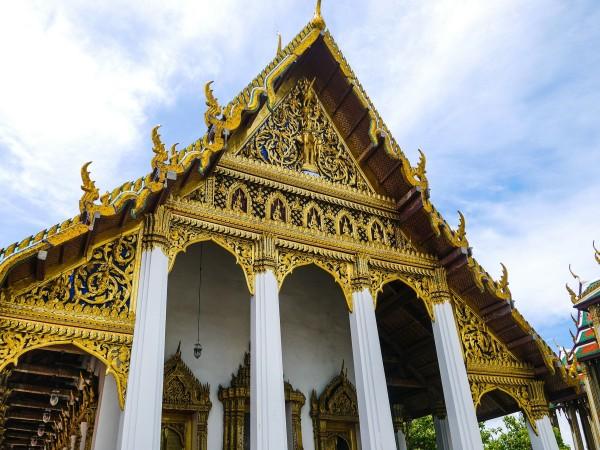
Overview of Bangkok
History & Culture Influence
Bangkok's history is as captivating as its present. The city was founded in 1782 by King Rama I and served as the capital of the Kingdom of Siam, which is now Thailand. The city’s history is deeply intertwined with its royal past, with the Grand Palace standing as a testament to its rich heritage. This royal palace, once the royal residence, is a dazzling complex of buildings showcasing intricate Thai architecture. Nearby, Wat Arun, or the Temple of Dawn, graces the riverside with its stunning spires, offering breathtaking views of the city. Each of these landmarks tells a story of Bangkok’s past, making them must-see attractions for any visitor.
Interaction with The Locals
Bangkok is the largest city in Thailand with its residents, known as Bangkokians, are a diverse mix of ethnicities, including Thai, Chinese, and Indian, reflecting the city’s rich cultural heritage. The people of Bangkok are known for their friendliness and hospitality, greeting visitors with welcoming hearts. Despite the city's fast-paced environment, Bangkokians maintain a strong sense of tradition and community, blending modernity with deep-rooted cultural practices.
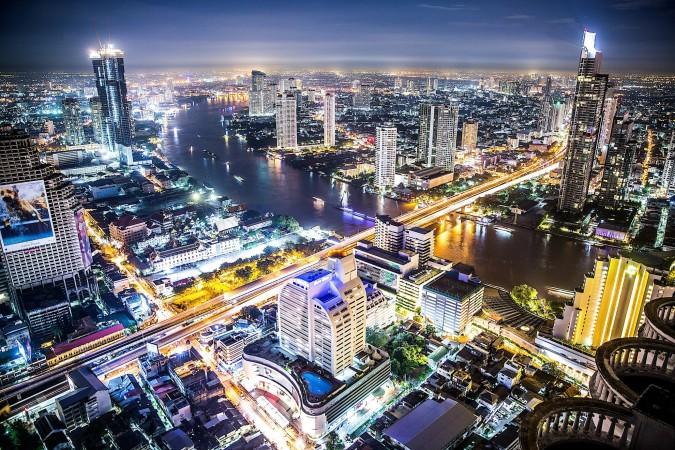
Bangkok, capital city of Thailand - © Braden Jarvis
Top Attractions in Bangkok
Must-Visit Sites in Bangkok
- The Grand Palace: The Grand Palace is Bangkok's most famous landmark and a symbol of the Thai monarchy. Its intricate architecture, golden spires, and detailed murals make it a breathtaking site to explore. The palace complex also houses the Temple of the Emerald Buddha, one of the most sacred sites in Thailand.
- Wat Pho: Wat Pho, popularly known as the Temple of the Reclining Buddha, boasts one of the world's biggest Buddha sculptures. This temple is both a spiritual retreat and a center for traditional Thai massage, providing the ideal combination of culture and relaxation.
- Wat Arun: Wat Arun, or the Temple of Dawn, is another must-see attraction in Bangkok. This temple, located on the banks of the Chao Phraya River, is well-known for its lofty spires that sparkle in the sun. A visit to Wat Arun provides both a spiritual experience and breathtaking views of the city.
- Chatuchak Weekend Market: For a true Bangkok shopping experience, visit Chatuchak Weekend Market, one of the largest markets in the world. With over 15,000 stalls, this market offers everything from antiques and clothing to street food and souvenirs. It's a vibrant, chaotic place that captures the essence of Bangkok.
Off-the-Beaten-Path Sites in Bangkok
- The Artist’s House (Baan Silapin): Tucked away in the Thonburi district, the Artist’s House (Baan Silapin) is a traditional wooden house where you can enjoy daily puppet shows that depict Thai folklore. This hidden gem in Bangkok offers a unique cultural experience away from the usual tourist crowds.
- Erawan Museum: The Erawan Museum is a serene escape from the hustle and bustle of Bangkok. Known for its gigantic three-headed elephant statue, the museum also boasts an impressive collection of art and religious artifacts, making it a peaceful retreat for art lovers.
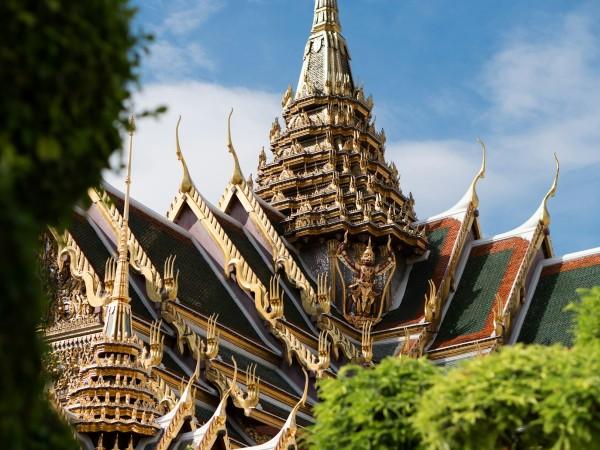
The magnificent traditional Thai architecture of the Grand Palace - © Tarun Ottur
Must-Try Dishes in Bangkok
Bangkok's cuisine is a reflection of the city's rich cultural heritage, offering a wide array of flavors that cater to every palate. From street food stalls to upscale restaurants, here are the must-try dishes that define Bangkok's culinary traditions.
- Pad Thai: Pad Thai is a quintessential Bangkok dish. This stir-fried noodle dish, made with shrimp or chicken, tofu, and crushed peanuts, is flavored with tamarind sauce, offering a perfect balance of sweet, sour, and savory.
- Som Tum (Green Papaya Salad): Som Tum is a popular Thai salad made from shredded green papaya, tomatoes, lime, and chili. Its refreshing yet spicy flavor makes it a favorite among locals and visitors.
- Tom Yum Goong (Spicy Shrimp Soup): Tom Yum Goong is a famous Thai soup known for its hot and sour flavors. Made with fresh shrimp, lemongrass, and lime leaves, it’s a flavorful dish that embodies the essence of Thai cuisine.
- Massaman Curry: Massaman Curry, a rich and creamy slow-cooked curry with Thai spices and a hint of Indian taste that is typically served with beef or chicken, is a delightful and substantial option.
- Mango Sticky Rice: Mango Sticky Rice, a traditional Thai dish, blends sweet, juicy mangoes with sticky rice cooked in coconut milk. It's a simple yet delightful way to end a meal in Bangkok.
- Moo Ping (Grilled Pork Skewers): Moo Ping is a popular street food in Bangkok. These marinated pork skewers are grilled to perfection and served with sticky rice, making for a tasty and convenient snack.
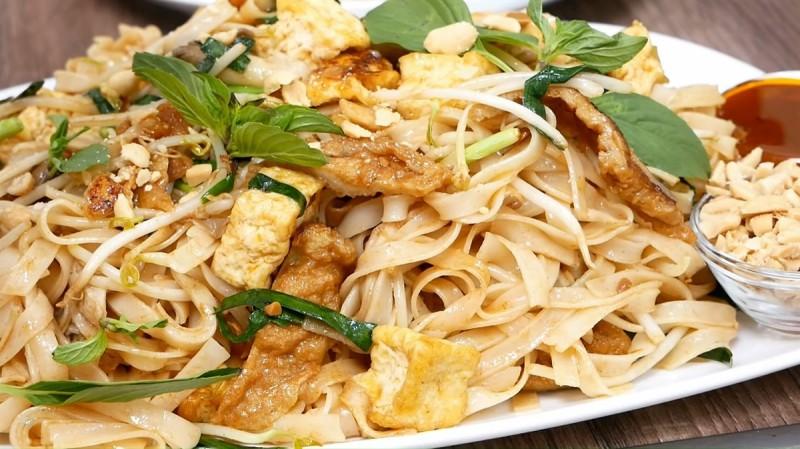
Pad Thai - © Foody
Festivals & Local Celebrations
Bangkok is a city that loves to celebrate, with festivals and events happening throughout the year. These celebrations are deeply rooted in Thai culture and traditions, offering visitors a chance to experience the local way of life.
Songkran Festival (Thai New Year)
Songkran, the Thai New Year, is the most famous festival in Bangkok. Celebrated in mid-April, it’s known for its massive water fights, where locals and tourists alike take to the streets to drench each other in water. This festival is not only a fun way to beat the heat but also a time for paying respect to elders and visiting temples.
Loy Krathong
LoLoy Krathong is one of Bangkok's most beautiful festivals, occurring on the full moon night of the 12th lunar month. During this occasion, residents float miniature adorned baskets called "krathongs" into rivers and canals to honor the water goddess. The sight of thousands of flickering candles on the water is truly magical.
Lunar New Year
Bangkok's lively Chinatown is the epicenter of Lunar New Year festivities. The area comes alive with dragon parades, firecrackers, and traditional performances. It’s a time when the Chinese-Thai community honors their ancestors and welcomes the new year with colorful festivities.
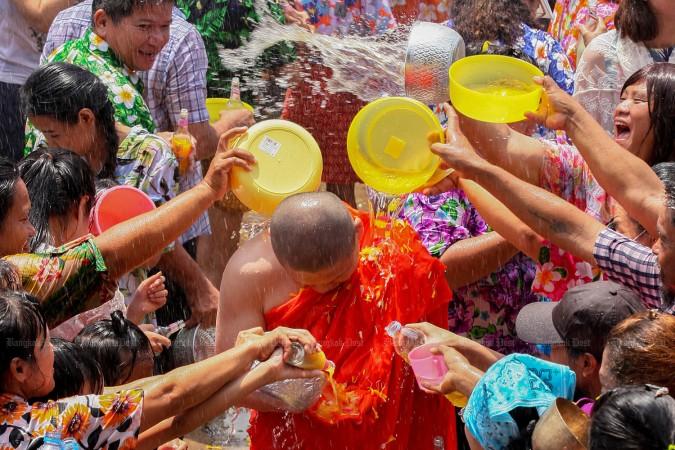
Songkran Festival (Thai New Year) - © Bangkok Post
What to Do in Bangkok
Bangkok offers a wealth of activities to suit every traveler. Discover the top things to do in Bangkok, from exploring stunning temples to enjoying boat rides and unique local experiences.
- Grand Palace and Wat Pho Tours: Discover Bangkok's architectural marvels at the Grand Palace and the Temple of the Reclining Buddha. These prominent locations provide a comprehensive look into Thailand's rich cultural and spiritual past.
- Chao Phraya River Cruises: Enjoy picturesque views of Bangkok’s skyline and riverside attractions with a scenic boat ride along the Chao Phraya River.
- Chatuchak Weekend Market Shopping: Experience the bustling atmosphere of Chatuchak Weekend Market, where you can find everything from clothes and crafts to street food.
- Floating Markets Cruises: Visit floating markets like Damnoen Saduak or Amphawa for a unique shopping experience on the water, featuring local produce and handmade goods.
- Experience Thai Massage: Unwind with a traditional Thai massage at a local spa or massage parlor, known for its therapeutic benefits and relaxation.
Shopping in Bangkok
Bangkok is renowned for its diverse shopping scene, offering everything from high-end malls to bustling markets, making shopping in this city an adventure in itself, where you can haggle for bargains or indulge in luxury shopping.
- Siam Paragon: Siam Paragon is one of Bangkok's most upscale retail complexes. It houses a vast array of international designer brands, gourmet restaurants, and even an aquarium.
- Chatuchak Weekend Market: This massive market is a labyrinth of stalls selling everything from antiques and clothing to food and souvenirs. It’s a vibrant, chaotic place where you can find unique items at bargain prices.
- MBK Center: MBK Center is a popular shopping destination for electronics, fashion, and accessories. It’s known for its affordable prices and a wide variety of products, making it a favorite among both locals and tourists.
- Asiatique The Riverfront: Asiatique The Riverfront is a trendy night market located along the Chao Phraya River. Combining shopping, dining, and entertainment, it offers a unique experience with a variety of boutiques and restaurants housed in restored warehouses.
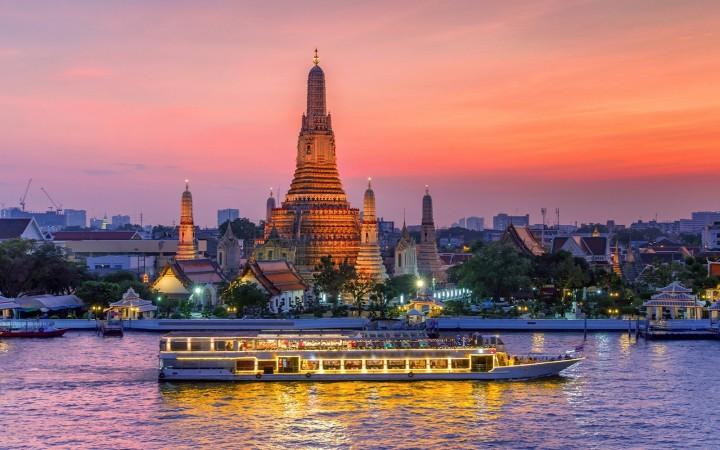
Chao Phraya River Cruises - © Thailand Tourism
Weather in Bangkok: Best Time to Visit
The city’s tropical climate features distinct seasons, each offering a unique experience for tourists. Understanding the city's climate change can help you make the most of your visit.
Cool Season in Bangkok
The cool season is the most popular time for tourists due to its comfortable temperatures and lower humidity. With daytime temperatures ranging from 20°C to 30°C (68°F to 86°F), this period is perfect for exploring Bangkok’s outdoor attractions and participating in city festivals. Expect clear skies and pleasant evenings, making it an ideal time for sightseeing and outdoor dining.
Hot Season in Bangkok
The hot season brings the highest temperatures, often reaching 35°C (95°F) or more. Despite the heat, this period is bustling with activity as tourists enjoy Bangkok’s vibrant street life and cultural events. It's a good time for indoor activities, such as visiting air-conditioned malls and museums. Stay hydrated and plan your outdoor activities for early morning or late afternoon to avoid the peak heat.
Rainy Season in Bangkok
The rainy season sees heavy showers and increased humidity, with occasional flooding. While the rain can be intense, it also revitalizes the city’s lush greenery and cooler temperatures. This season offers a quieter, less crowded experience, ideal for visiting indoor attractions like temples and markets. Rain gear is essential, but the showers often come in short bursts, leaving plenty of time for exploring.
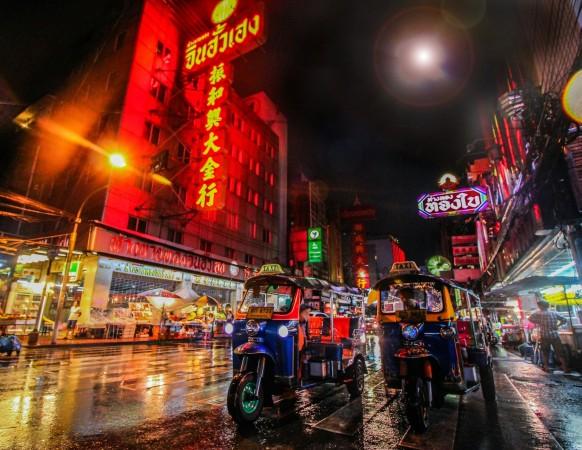
Experience the bustling Chinatown in Bangkok in any weather - © Florian Wehde
Culture Etiquette in Bangkok
Learn about Bangkok’s cultural etiquette, including unique local customs and practices, to ensure respectful and enjoyable interactions during your visit.
- The Wai Greeting: The "wai" is a traditional Thai greeting in which you put your palms together and bow slightly to show respect. It is typically performed when meeting elders or during formal interactions. You’ll often receive a wai in return, especially in more formal or traditional settings.
- Respect for the Royal Family: In Thailand, the monarchy is highly venerated. Avoiding unfavorable remarks is a vital way to show respect for the royal family. Standing during the national anthem, which plays before films and some public events, is also a sign of respect.
- Modest Dress Code for Temples: When visiting temples or royal sites, dress modestly. This means covering your shoulders and knees, and avoiding clothing that is too tight or revealing. Many temples provide shawls or cover-ups for visitors who are not dressed appropriately.
- Avoid Touching Heads: In Thai culture, the head is regarded as the most holy part of the body, therefore, avoid touching anyone's head, especially youngsters. This custom reflects the deep respect for personal space and the sacredness of the head.
Essential Travel Information
Getting Around Bangkok
- BTS Skytrain: The BTS Skytrain provides a quick and effective method to get around Bangkok. It connects major areas and attractions, reducing the hassle of traffic and offering a comfortable ride.
- MRT Subway: The MRT Subway complements the BTS and provides access to other parts of the city not covered by the Skytrain. It’s a reliable option for getting to various destinations.
- Tuk-Tuks: Tuk-tuks are a fun and iconic way to travel short distances. These three-wheeled vehicles offer an open-air experience and are great for quick trips around the city.
- River Boats: Utilize Bangkok’s river boat services for a scenic and practical travel option. Boats travel along the Chao Phraya River, providing picturesque views and access to riverside attractions.
- Taxis and Ride-Sharing Apps: Taxis and ride-sharing apps are widely available, offering convenient options for getting around. Make sure to insist on utilizing the meter or agree on a fare before beginning the journey.
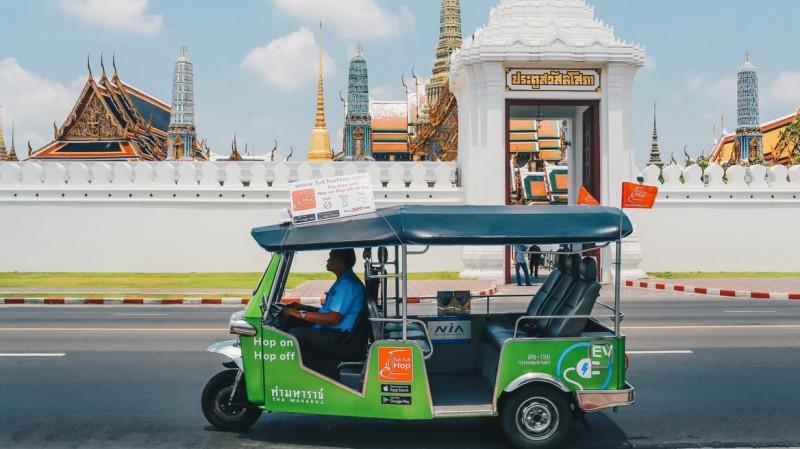
Tuk-Tuks in Bangkok - © Thailand Tourism
ATM & Banking Services
Managing your finances in Bangkok is convenient with a variety of banking services available throughout the city. ATMs are plentiful, located at airports, shopping centers, and street corners, accepting major international credit and debit cards. Be mindful of potential transaction fees from your home bank. Currency exchange services are easily accessible at airports, banks, and dedicated exchange booths, where rates can vary, so it’s wise to compare options. While credit and debit cards are widely accepted at hotels, restaurants, and shops, carrying some cash is advisable for small purchases and local street vendors.
Where to Stay in Bangkok
- Luxury Hotels: Bangkok boasts numerous luxury hotels with top-notch amenities, offering exceptional service, stunning views, and elegant surroundings. These hotels provide a premium experience with features like fine dining, spas, and high-end rooms.
- Budget Hostels: Travelers on a budget can find affordable hostels scattered throughout the city. These hostels offer basic amenities and a social environment, ideal for meeting fellow travelers and exploring Bangkok without breaking the bank.
- Guesthouses: Guesthouses offer a comfortable and affordable middle ground. They typically provide cozy accommodations with friendly service, making them a great choice for a welcoming and relaxed stay.
- Homestays: Homestays offer a unique way to experience Thai daily life and hospitality. These lodgings allow visitors to stay with local families, providing an immersive cultural experience.
Articles for you

Explore Yala National Park - Sri Lanka Travel, Asia
Tucked away in Sri Lanka’s southeastern corner, Yala National Park is where wild nature meets deep tradition. Known worldwide for its leopard population, the park is also home to elephants, sloth bears, crocodiles, and hundreds of bird species. Beyond wildlife, Yala opens doors to a cultural landscape dotted with ancient temples, Buddhist ruins, and coastal villages. For travelers seeking more than just a safari, Yala offers a chance to explore eco-tourism, local communities, and sacred heritage sites.
Population: The Yala National Park area doesn’t have a human population.
Economy: The economy around Yala National Park thrives on a blend of eco-tourism, agriculture, and local services. Safari tours, eco-lodges, and cultural experiences drive steady income for nearby towns like Tissamaharama and Kataragama, supporting thousands of families.
Landmarks: Famous for Block I of Yala and wildlife encounters, including elephants, sloth bears, crocodiles, and exotic bird species.

Explore Galle - Sri Lanka Travel, Asia
Nestled on Sri Lanka’s southern coastline, Galle is a vibrant city where history meets the sea. Its cobbled streets, colonial architecture, and serene beaches make it a must-visit destination for travelers seeking a blend of culture, adventure, and relaxation. A UNESCO World Heritage site, Galle captivates visitors with its Dutch Fort, bustling markets, and friendly locals. Whether you’re exploring the ramparts at sunset or savoring fresh seafood by the shore, Galle promises an unforgettable journey into Sri Lanka’s heritage.
Population: Approximately 113,000 in 2023.
Economy: Galle’s economy thrives on tourism, trade, and fisheries. The city’s historic fort, colonial architecture, and coastal charm draw thousands of international visitors each year, making tourism its main economic driver. Fishing remains vital for local livelihoods, supplying fresh seafood across the region.
Landmarks: Famous for the Galle Fort, Dutch Reformed Church & Maritime Museum, and Unawatuna Beach.

Explore Bentota - Sri Lanka Travel, Asia
Nestled along Sri Lanka’s southwestern coast, Bentota is a tropical paradise that blends golden beaches, vibrant culture, and thrilling adventures. Famous for its calm waters, luxury resorts, and scenic river estuary, Bentota has become a top destination for travelers seeking both relaxation and authentic experiences. From serene beach walks at sunrise to adrenaline-pumping water sports, this coastal town offers a perfect balance of leisure and exploration. With its proximity to Colombo and Galle, Bentota is easy to reach, making it an ideal stop for both short escapes and extended holidays.
Population: Approximately 37,000 in 2023.
Economy: Bentota’s economy thrives mainly on tourism, which drives local businesses such as hotels, restaurants, and wellness retreats. The town also benefits from fishing, coconut cultivation, and handicrafts like wood carving and batik textiles. Many residents rely on the growing demand for water sports and Ayurvedic treatments, making tourism the backbone of both income and employment in the area.
Landmarks: Famous for Bentota Beach, Bentota River Safari, and Kande Vihara Temple.

Explore Mirissa - Sri Lanka Travel, Asia
Mirissa is a charming coastal town on Sri Lanka’s southern shoreline. Known for its golden beaches, turquoise waters, and vibrant marine life, it has become a must-visit stop for travelers exploring the island. Many come for whale watching, surfing, and sunset views at Coconut Tree Hill, but Mirissa offers much more than postcard beauty. The fishing boats you see anchored by the bay carry generations of stories. Local traditions, delicious cuisine, and a laid-back rhythm of life shape every visitor’s experience.
Population: Approximately 4,700 in 2023.
Economy: Mirissa’s economy is largely shaped by its coastal location. Fishing has long been the backbone of local livelihoods, with generations relying on the Indian Ocean for income. In recent decades, tourism has become the main driver of growth, thanks to whale watching, surfing, and beachside hospitality.
Landmarks: Famous for Mirissa Beach, Coconut Tree Hill, and Parrot Rock Bridge.

Explore Nuwara Eliya - Sri Lanka Travel, Asia
Tucked away in the Central Highlands of Sri Lanka, Nuwara Eliya is often called “Little England”. With its rolling tea plantations, cool misty mornings, and colonial charm, this mountain town feels like a step into another world. Travelers come here to breathe fresh air, walk through flower gardens, sip the finest Ceylon Tea, and enjoy a pace of life far from the island’s busy cities. Whether you’re drawn by scenic landscapes, heritage architecture, or the warmth of its people, Nuwara Eliya is a destination that blends nature, culture, and history in perfect harmony.
Population: Approximately 781,000 in 2023.
Economy: Nuwara Eliya’s economy thrives mainly on tea production, as it sits in the heart of Sri Lanka’s central highlands, famous worldwide for Ceylon Tea. The city also benefits from a growing tourism industry, attracting visitors with its colonial charm, cool climate, and scenic landscapes.
Landmarks: Famous for Gregory Lake, Hakgala Botanical Garden, and Victoria Park.

Explore Sukau - Malaysia Travel, Asia
Nestled on the banks of the Kinabatangan River in Sabah, Malaysian Borneo, Sukau is a destination where wildlife, culture, and conservation come together. Known as one of Asia’s top spots for river safaris and eco-tourism, this quiet village offers a front-row seat to encounters with Bornean orangutans, pygmy elephants, proboscis monkeys, and exotic birdlife.
Population: Approximately 1,400 in 2019.
Economy: Sukau’s economy is shaped by its riverine location and natural resources. Traditionally, the Orang Sungai community relied on fishing, small-scale farming, and forest gathering for their livelihood. Today, the village has shifted toward eco-tourism, with river cruises, jungle trekking, and homestays providing income.
Landmarks: Famous for the Kinabatangan River cruises, Gomantong Caves, and Ox-bow lakes and wetlands.
